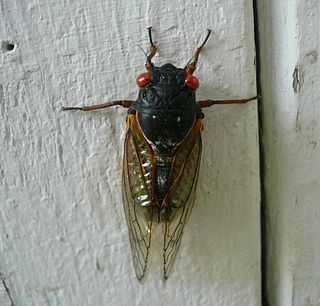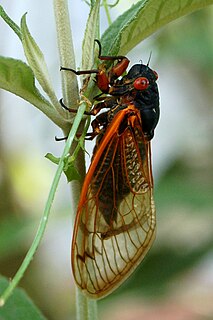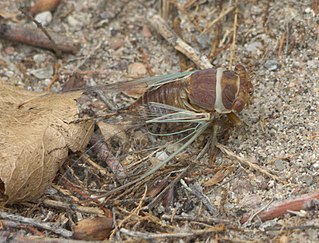Related Research Articles

The cicadas are a superfamily, the Cicadoidea, of insects in the order Hemiptera. They are in the suborder Auchenorrhyncha, along with smaller jumping bugs such as leafhoppers and froghoppers. The superfamily is divided into two families, Tettigarctidae, with two species in Australia, and Cicadidae, with more than 3,000 species described from around the world; many species remain undescribed.

Brood X, the Great Eastern Brood, is one of 15 broods of periodical cicadas that appear regularly throughout the eastern United States. It has the greatest range and concentration of any of the 17-year cicadas.

Magicicada is the genus of the 13-year and 17-year periodical cicadas of eastern North America, consisting of seven species. Although they are sometimes called "locusts", this is a misnomer, as cicadas belong to the taxonomic order Hemiptera, suborder Auchenorrhyncha, while locusts are grasshoppers belonging to the order Orthoptera. Magicicada belongs to the cicada tribe Lamotialnini, a group of genera with representatives in Australia, Africa, and Asia, as well as the Americas.

Cicadas of the genus Neotibicen are large-bodied insects of the family Cicadidae that appear in summer or early fall in eastern North America. Common names include cicada, harvestfly, jar fly, and the misnomer locust. Until recently, these species were all in the genus Tibicen, which was redefined in the twenty-first century to include only a few European species, while species from the Western United States and Mexico are now placed in a separate genus, Hadoa. In addition, several former Neotibicen species have been moved to the genus Megatibicen.

Charles Lester Marlatt (1863–1954) was an American entomologist. Born in 1863 at Atchison, Kansas, he was educated at Kansas State Agricultural College, where he was assistant professor for two years. He is the person who introduced the ladybug insect Chilocorus similis into the United States to control the San Jose scale insect, which was first discovered in San Jose, California in 1880 by John Henry Comstock and named by him. Marlatt worked for the Bureau of Entomology, United States Department of Agriculture. In 1912 he was appointed chairman of the Federal Horticultural Board. He was president of the Entomological Society of Washington in 1897–98 and of the American Association of Economic Entomologists in 1899.

Brood XIII is one of 15 separate broods of periodical cicadas that appear regularly throughout the midwestern United States. Every 17 years, Brood XIII tunnels en masse to the surface of the ground, mates, lays eggs, and then dies off in several weeks.

Brood XIX is the largest brood of 13-year periodical cicadas, last seen in 2011 across a wide stretch of the southeastern United States. Periodical cicadas are often referred to as "17-year locusts" because most of the known distinct broods have a 17-year life cycle. Brood XIX is one of only three surviving broods with a 13-year cycle. It is also notable because it includes four different 13-year species, one of which was discovered in Brood XIX in 1998 by scientists listening to cicada songs.

Magicicada cassinii, sometimes called the 17-year cicada, Cassin's periodical cicada or the dwarf periodical cicada, is a species of periodical cicada. It is endemic to North America. It has a 17-year lifecycle but is otherwise indistinguishable from the 13-year periodical cicada Magicicada tredecassini. The two species are usually discussed together as "cassini periodical cicadas" or "cassini-type periodical cicadas." Unlike other periodical cicadas, cassini-type males may synchronize their courting behavior so that tens of thousands of males sing and fly in unison. The specific name cassinii was in honour of John Cassin, an American ornithologist.

Magicicada septendecim, sometimes called the Pharaoh cicada or the 17-year locust, is native to Canada and the United States and is the largest and most northern species of periodical cicada with a 17-year lifecycle.

Massospora cicadina is a fungal pathogen that infects only 13 and 17 year periodical cicadas. Infection results in a "plug" of spores that replaces the end of the cicada's abdomen while it is still alive, leading to infertility, disease transmission, and eventual death of the cicada.
Magicicada neotredecim is the most recently discovered species of periodical cicada. Like all Magicicada species, M. neotredecim has reddish eyes and wing veins and a black dorsal thorax. It has a 13-year life cycle but seems to be most closely related to the 17-year species Magicicada septendecim. Both species are distinguished by broad orange stripes on the abdomen and a unique high-pitched song said to resemble someone calling "weeeee-whoa" or "Pharaoh." They differ only in life cycle length.
Magicicada tredecim is a 13-year species of periodical cicada, closely related to the newly discovered 13-year species Magicicada neotredecim, from which it differs in male song pitch, female song pitch preferences, abdomen color, and mitochondrial DNA. Both M. tredecim and M. neotredecim are closely related to the 17-year species M. septendecim, which was identified by Linnaeus in 1758; these three species are often grouped together under the name decim periodical cicadas.

Decim periodical cicadas is a term used to group three closely related species of periodical cicadas: Magicicada septendecim, Magicicada tredecim, and Magicicada neotredecim. M. septendecim, first described by Carl Linnaeus, has a 17-year life cycle; the name septendecim is Latin for 17. M. tredecim, first described in 1868, has a similar call and appearance but a 13-year life cycle; tredecim is Latin for 13. M. neotredecim, first described in 2000 by Marshall and Cooley in an article in the journal Evolution, is a 13-year species but otherwise much more similar to M. septendecim than to M. tredecim as shown by studies of DNA and abdominal color variation by Chris Simon and colleagues in a companion article in the same journal issue.

The Cassini periodical cicadas are a pair of closely related species of periodical cicadas: Magicicada cassinii, having a 17-year lifecycle, and Magicicada tredecassini, a nearly identical species with a 13-year lifecycle.

Magicicada tredecassini is a species of periodical cicada endemic to the United States. It has a 13-year lifecycle but is otherwise indistinguishable from the 17-year periodical cicada Magicicada cassini. The two species are usually discussed together as "cassini periodical cicadas" or "cassini-type periodical cicadas." Unlike other periodical cicadas, cassini-type males may synchronize their courting behavior so that tens of thousands of males sing and fly in unison.

Okanagana is a genus of cicadas in the family Cicadidae. There are at least 60 described species in Okanagana.

Diceroprocta is a genus of scrub cicadas in the family Cicadidae. There are at least 60 described species in Diceroprocta.

Diceroprocta apache, the citrus cicada, is a species of cicada in the family Cicadidae. It is found in Central America and North America.
Diceroprocta averyi is a species of cicada in the family Cicadidae. It is found in North America.
Brood IX, is one of 15 broods of periodical cicadas that appear regularly throughout the United States in 13- or 17-year intervals. Seventeen-year Brood IX is concentrated in Virginia, West Virginia, and North Carolina.
References
- ↑ "Cicada Central". University of Connecticut. Archived from the original on 9 June 2011. Retrieved 13 June 2011.CS1 maint: discouraged parameter (link)
- ↑ Diceroprocta vitripennis Archived July 25, 2011, at the Wayback Machine
- ↑ Cicadamania: "Hot weather means cicadas emerge sooner"
- ↑ "Periodical Cicada Page". University of Michigan. Archived from the original on 20 July 2011. Retrieved 13 June 2011.
To learn about some of the common annual cicada species of eastern North America (including the genera Tibicen, Diceroprocta, and Okanagana), and to hear their songs, see our Michigan Cicadas Page.
CS1 maint: discouraged parameter (link)